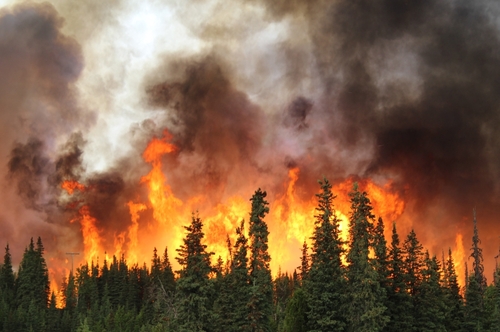
Lung cancer is the second most common cancer diagnosis and the leading cause of cancer-related death in the United States. For individuals with non-small cell lung cancer (NSCLC), surgical resection has been associated with the best prognosis. However, exposure to wildfire smoke—a major contributor to air pollution—has been shown to decrease the chances of lung cancer survival.
Some populations are at higher risk from the adverse health effects related to proximity to wildfire, and identifying these populations is critical for disaster preparedness and climate change efforts. Because of climate change, wildfire activity in the Unites States has dramatically risen. Exposure to wildfire smoke has been linked to respiratory morbidity, including lung cancer risk, and exposure to wildfire particulate matter smaller than 2.5 µm has been associated with cancer mortality. Proximity to wildfire, however, leads not only to increased exposure to air pollution from the smoke plume, but also to health hazards from water and soil contamination. In addition to the health consequences of inhaling wildfire smoke, increased stress and mental health issues, forced displacement, and disruptions in access to care may impact long-term overall survival (OS) among individuals recovering from lung cancer surgery.
Danlu Zhang, MPH, and colleagues sought to assess the association between proximity to wildfire and postoperative long-term OS among patients with lung cancer in the United States. Results were reported in JAMA Oncology [2023;9(9):1214-1220].
In this cohort study, the researchers identified individuals who were discharged from the hospital following curative-intent resection for stage I to III NSCLC between January 1, 2004, and December 31, 2019, using the National Cancer Database. Exclusion criteria included individuals with missing age at diagnosis, missing sex, stage IV NSCLC or missing stage at diagnosis, missing vital status, missing date of last contact, or residence in counties where no patients were exposed to a wildfire. Daily wildfire information was gathered at the zip code level from the National Aeronautics and Space Administration Fire Information for Rescue Management System. The data analysis was performed between July 19, 2022, and April 14, 2023. Exposure was identified as an active wildfire detected at the zip code of residence between 0 to 3 months, 4 to 6 months, or 7 to 12 months after NSCLC surgery.
The primary end point was OS, which was defined as the interval between age at hospital discharge and age at death, last contact, or study end, whichever came first. The researchers used Cox proportional hazards to estimate hazard ratios (HRs) adjusted for sex, region, metropolitan category, health insurance type, comorbidities, tumor size, lymph node involvement, era, and facility type.
Of the 446,912 individuals included (53.4% were women and 46.6% were men, with a mean age of 67 years), 10.4%, 10.6%, and 15.3% were first exposed to a wildfire within 3 months, 4 to 6 months, or 7 to 12 months, respectively, following curative-intent surgery for NSCLC. Individuals exposed to a wildfire within 3 months of discharge from the hospital compared with those unexposed following hospital discharge were more likely to be younger and male, have stage II disease, reside in the South, lack private health insurance coverage, be treated at comprehensive cancer centers, have comorbidities, reside outside of metropolitan areas, and reside in areas with lower income. The median follow-up was 39 months.
The findings showed that exposure to a wildfire within 1 year of NSCLC surgery may significantly lower OS. Individuals exposed to a wildfire within 3 months (adjusted HR [aHR], 1.43; 95% CI, 1.41-1.45), 4 to 6 months (aHR, 1.39; 95% CI, 1.37-1.41), and 7 to 12 months (aHR, 1.17; 95% CI, 1.15-1.19) had worse OS outcomes compared with those unexposed to a wildfire. Wildfire exposure within 3 months, 4 to 6 months, and 7 to 12 months following discharge from the hospital was significantly associated with worse OS following resection of stage I, II, and III NSCLC.
According to the researchers, strategies for disaster preparedness and response to wildfires should consist of approaches for identifying and contacting individuals recovering from lung surgery; providing a portable medical card with diagnosis, treatment, and survivorship information; and offering information on how to create an evacuation plan, register for special needs shelters, access mental health resources, and decrease exposure to contaminated air, soil, and water.
The authors cited study limitations, including a lack of data about smoking history, performance status, specific cause of death, wildfire intensity and duration, wildfire-related displacement, and wildfire-related socioeconomic, psychologic, and physical health consequences. They suggested that future studies evaluate the specific detrimental effects of exposure to wildfires to inform targeted strategies to protect the health and safety of this patient population.
“The findings of this cohort study indicate that individuals recovering from lung cancer surgery are at higher risk from the health threats of wildfires,” the researchers concluded. “Strategies for identifying and prioritizing this medically high-risk population in wildfire-specific emergency preparedness and response efforts nationally are crucial for improving adaptive capacity in the era of climate change.”







 © 2025 Mashup Media, LLC, a Formedics Property. All Rights Reserved.
© 2025 Mashup Media, LLC, a Formedics Property. All Rights Reserved.